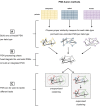Heterogeneous data integration methods for patient similarity networks
- PMID: 35679533
- PMCID: PMC9294435
- DOI: 10.1093/bib/bbac207
Heterogeneous data integration methods for patient similarity networks
Abstract
Patient similarity networks (PSNs), where patients are represented as nodes and their similarities as weighted edges, are being increasingly used in clinical research. These networks provide an insightful summary of the relationships among patients and can be exploited by inductive or transductive learning algorithms for the prediction of patient outcome, phenotype and disease risk. PSNs can also be easily visualized, thus offering a natural way to inspect complex heterogeneous patient data and providing some level of explainability of the predictions obtained by machine learning algorithms. The advent of high-throughput technologies, enabling us to acquire high-dimensional views of the same patients (e.g. omics data, laboratory data, imaging data), calls for the development of data fusion techniques for PSNs in order to leverage this rich heterogeneous information. In this article, we review existing methods for integrating multiple biomedical data views to construct PSNs, together with the different patient similarity measures that have been proposed. We also review methods that have appeared in the machine learning literature but have not yet been applied to PSNs, thus providing a resource to navigate the vast machine learning literature existing on this topic. In particular, we focus on methods that could be used to integrate very heterogeneous datasets, including multi-omics data as well as data derived from clinical information and medical imaging.
Keywords: biomedical applications; data fusion; multimodal data; patient similarity networks.
© The Author(s) 2022. Published by Oxford University Press.
Figures




Similar articles
-
Network-based integration of multi-omics data for clinical outcome prediction in neuroblastoma.Sci Rep. 2022 Sep 14;12(1):15425. doi: 10.1038/s41598-022-19019-5. Sci Rep. 2022. PMID: 36104347 Free PMC article.
-
Integrate multi-omics data with biological interaction networks using Multi-view Factorization AutoEncoder (MAE).BMC Genomics. 2019 Dec 20;20(Suppl 11):944. doi: 10.1186/s12864-019-6285-x. BMC Genomics. 2019. PMID: 31856727 Free PMC article.
-
MMGCN: Multi-modal multi-view graph convolutional networks for cancer prognosis prediction.Comput Methods Programs Biomed. 2024 Dec;257:108400. doi: 10.1016/j.cmpb.2024.108400. Epub 2024 Sep 6. Comput Methods Programs Biomed. 2024. PMID: 39270533
-
A review on machine learning principles for multi-view biological data integration.Brief Bioinform. 2018 Mar 1;19(2):325-340. doi: 10.1093/bib/bbw113. Brief Bioinform. 2018. PMID: 28011753 Review.
-
Algorithms and tools for data-driven omics integration to achieve multilayer biological insights: a narrative review.J Transl Med. 2025 Apr 10;23(1):425. doi: 10.1186/s12967-025-06446-x. J Transl Med. 2025. PMID: 40211300 Free PMC article. Review.
Cited by
-
MoNETA: MultiOmics Network Embedding for SubType Analysis.NAR Genom Bioinform. 2024 Oct 16;6(4):lqae141. doi: 10.1093/nargab/lqae141. eCollection 2024 Sep. NAR Genom Bioinform. 2024. PMID: 39416887 Free PMC article.
-
Constructing a Clinical Patient Similarity Network of Gastric Cancer.Bioengineering (Basel). 2024 Aug 9;11(8):808. doi: 10.3390/bioengineering11080808. Bioengineering (Basel). 2024. PMID: 39199766 Free PMC article.
-
miss-SNF: a multimodal patient similarity network integration approach to handle completely missing data sources.Bioinformatics. 2025 Mar 29;41(4):btaf150. doi: 10.1093/bioinformatics/btaf150. Bioinformatics. 2025. PMID: 40184204 Free PMC article.
-
Subgrouping testicular germ cell tumors based on immunotherapy and chemotherapy associated lncRNAs.Heliyon. 2024 Jan 8;10(2):e24320. doi: 10.1016/j.heliyon.2024.e24320. eCollection 2024 Jan 30. Heliyon. 2024. PMID: 38298718 Free PMC article.
-
StellarPath: Hierarchical-vertical multi-omics classifier synergizes stable markers and interpretable similarity networks for patient profiling.PLoS Comput Biol. 2024 Apr 12;20(4):e1012022. doi: 10.1371/journal.pcbi.1012022. eCollection 2024 Apr. PLoS Comput Biol. 2024. PMID: 38607982 Free PMC article.
References
Publication types
MeSH terms
Grants and funding
- BB/F00964X/1/BB_/Biotechnology and Biological Sciences Research Council/United Kingdom
- BB/M025047/1/BB_/Biotechnology and Biological Sciences Research Council/United Kingdom
- BB/K004131/1/BB_/Biotechnology and Biological Sciences Research Council/United Kingdom
- MR/T001070/1/MRC_/Medical Research Council/United Kingdom
LinkOut - more resources
Full Text Sources
Other Literature Sources

